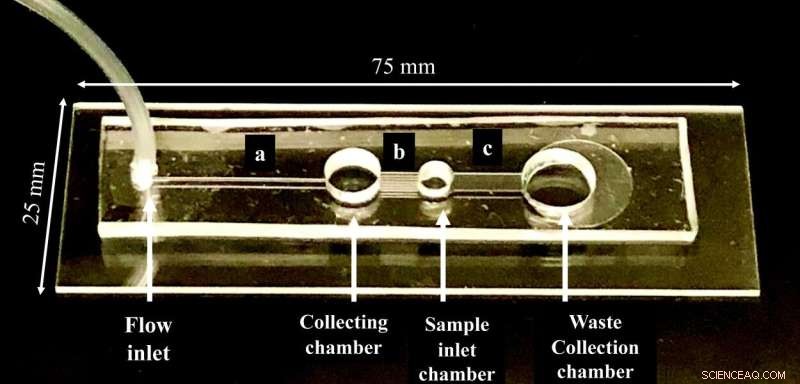
Mikrofluidchipet består av fyra cylindriska kammare anslutna genom mikrokanaler:vätskeinloppskammaren, uppsamlingskammaren, provinloppskammaren och avfallsuppsamlingskammaren. Kredit:Florida Atlantic University
Det kvinnliga könsorganet kan vara en fientlig miljö för befruktning. Av cirka 100 miljoner spermier är det bara några hundra som når äggledarna. Styrd av en riktad rörelse som kallas reotaxi simmar spermieceller mot livmoderhalsslemflödet för att nå ägget för befruktning. Denna resa är dock ännu mer kritisk när man överväger infertilitet. Spermierörlighet - förmågan att simma på rätt sätt - är nyckeln.
Genom att dra fördel av detta naturliga reotaxibeteende hos spermier har forskare från Florida Atlantic Universitys College of Engineering and Computer Science utvecklat ett mikrofluidiskt chip för spermiesortering som är snabbt, billigt, lätt att använda och effektivt isolerar friska spermier direkt från sperma. Viktigt är att den utan ansträngning samlar sorterade spermaceller från uppsamlingskammaren samtidigt som kontaminering av deformerade eller döda spermaceller minimeras.
Assisterad reproduktionsteknologi som in vitro fertilisering (IVF), intrauterin insemination och intracytoplasmatisk spermieinjektion kräver alla friska spermier för ett framgångsrikt resultat. Nuvarande centrifugeringsmetoder för spermiesortering kräver flera steg, flera typer av utrustning och tar cirka två timmar att isolera spermieceller. Dessa metoder skadar spermier under bearbetning och inducerar betydande DNA-fragmentering och oxidativ stress.
Resultaten av studien, publicerade i tidskriften The Analyst från Royal Society of Chemistry, visade att spermieceller isolerade från uppsamlingskammaren i detta mikrofluidiska chip uppvisade signifikant högre motilitet (nästan 100 procent), ett högre antal morfologiskt normala celler och avsevärt lägre DNA-fragmentering, vilket är en avgörande parameter för befruktningsprocess. Dessutom ger det utvecklade chipet mer än tillräckligt med celler som krävs för en framgångsrik intracytoplasmatisk spermieinjektion på grund av mängden och kvaliteten på spermieceller som isolerats med chipet.
"Det är väldigt enkelt att använda vårt chip. När sperman väl har laddats in i provinloppskammaren börjar de kompetenta spermiecellerna röra sig mot vätskeflödet mot uppsamlingskammaren varifrån de lätt kan samlas in", säger Waseem Asghar, Ph.D. , senior författare, docent vid FAU:s institution för elektroteknik och datavetenskap, och medlem av FAU Institute for Human Health and Disease Intervention (I-Health) och FAU Institute for Sensing and Embedded Network Systems Engineering (I-SENSE) . "Dessutom erbjuder detta chip en ettstegs, en timmes driftsfördel, som en operatör kan använda med minimal träning."
The study also validates that rheotaxis selects the healthy, motile, and higher velocity sperm cells for the fertilization process.
"The assembly of the microfluidic chip is low-cost, and the reagents used in the chip to separate sperm cells are only a few milliliters, therefore, the commercial cost of the chip would be less than $5," said Asghar. "Moreover, this technology will considerably reduce the economic burden of fertility implementations and both the chip and the sperm cells isolated from it offer great clinical significance and applicability."
The microfluidic chip consists of four cylindrical chambers that are connected through the microchannels. The four chambers are the fluid inlet chamber, collecting chamber, sample inlet chamber, and waste collection chamber. The channel between the collecting chamber and sample inlet contains microgrooves to guide the sperm cells in addition to the fluid flow for the rheotaxis movement of the sperm cells towards the collecting chamber.
The shear stress inside the device is generated by fluid flow using a syringe pump. A raw semen sample is then added to the sample inlet chamber from where functional sperm cells will swim towards the collecting chamber, effectively separating themselves from dead and immotile sperm.
"Conventional centrifugation often compromises the integrity of sperm cells. This research study demonstrates that the microfluidic chip developed by professor Asghar and his colleagues eliminates this issue," said Stella Batalama, Ph.D., dean, College of Engineering and Computer Science. "This novel technology offers a platform where the sperm cells experience different shear stress in different parts of the chip, which facilitates the isolation of competent sperm cells without impacting their integrity."
In the United States, an estimated 15 percent of couples have trouble conceiving. Globally, approximately 48.5 million couples experience infertility. According to the U.S. Centers for Disease Control and Prevention, 12 percent of women of childbearing age have used an infertility service. All treatment costs for infertility can range from $5,000 to $73,000. The average patient goes through two IVF cycles, bringing the total cost of this procedure, including medications, between $40,000 and $60,000. An estimated 85 percent of IVF costs are often paid out-of- pocket. + Utforska vidare